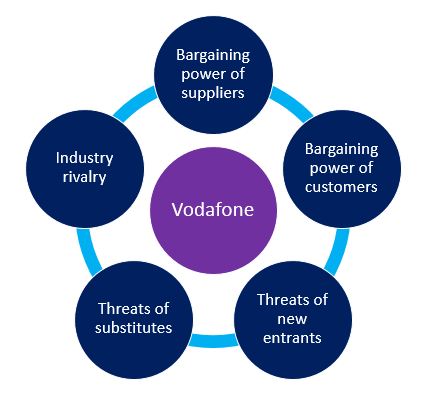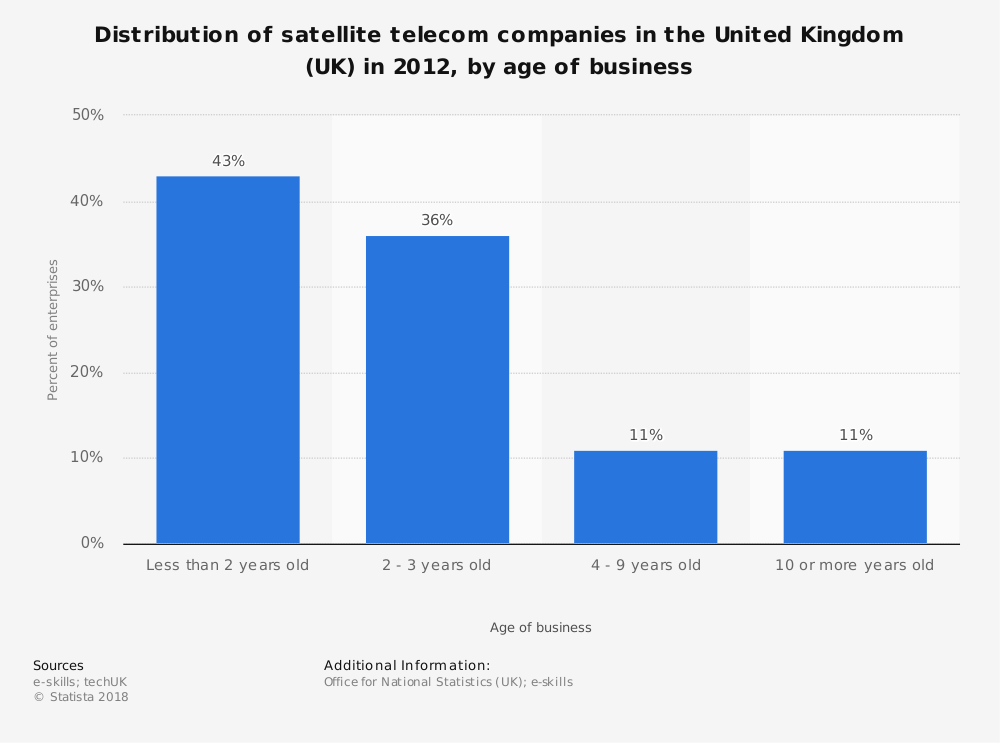Introduction
Porter’s Five Forces model analyses the competitive environment of organisations. This model critically explores the influences of external competitive forces on the business. Therefore, it helps to find out the present competition of the company. By analysing the model, Vodafone will be able to build sustainable competitive advantage in the telecommunication sector. This article presents Porter’s Five Forces Model of Vodafone.
Analysis of Porter’s Five Forces Model of Vodafone

Threat of new entrants
The threat of new entrants is one of the dimension of Porter’s Five Forces model of Vodafone. The competition in telecommunication sector is increasing and it is a major threat of Vodafone. Below bar graph is captured from Statista (2019) showing the percentage of businesses having started in different ages in the UK market in telecommunication sector. It shows that a large number of companies (43%) started business in Telecommunication sector in the UK in last 2 years. Talk Talk, Xaomi, Huawei, OPPO etc. are some of the companies having extensive dominance in the UK market and in rest of the world.
New entrants will bring innovation and developed products which will help them to replace Vodafone. The company should keep innovating to provide new products and services to customers. They can reduce price by controlling operational cost which will attract many customers. Investment in R&D will help them to keep updated their service and will be able to remain as a strong player.
Bargaining power of Buyers
Bargaining power of buyers is another dimension of Porter’s Five Forces model of Vodafone. Buyers are too much demanding and they want best advantages within low costs. This has resulted from the offers regarding services, rates presented by competitors such as Virgin Group, O2, Three UK, EE etc. companies. Vodafone still have much opportunities to attract customers’ attention by improving customer services, after sales services, tax avoidance blame.
You may also like to read below blog posts: PESTLE analysis of Vodafone Ansoff Matrix for Vodafone Stakeholder analysis for Vodafone Strategic planning for Vodafone
Strategic Planning for Kellog's
Bargaining Power of Suppliers
The bargaining power of suppliers entail the relative power of suppliers to bargain with the company on different terms of negotiation, quality, pricing etc. This is an important dimension of Porter’s Five Forces model of Vodafone. Companies of telecommunication sector purchases different components from suppliers all around the world. They remain in the dominant position and have the power of reducing margin of Vodafone. Suppliers use their negotiationg power and set high price of the components. Such components and supports may include cheaps, processors, RAM, ROM, cameras, mobile frames, televisions and so on to name a few. Vodafone has to build strong connection with multiple suppliers to have good command and high level of flexibility over customer selection. They can find developing dedicated farm because their business will be influenced by Vodafone’s order. These types of suppliers will be obliged toward Vodafone and the company will get row materials within low price. It will increase their profit level.
Threat of Substitute products
Threat of substitutes is another dimension of Porter’s Five Forces model of Vodafone. This dimension entails the relative chances that customers can meet their needs through alternative products and services. Substitute product can harm the profitability of Vodafone negatively. The company faces low threat of substitute products because it is difficult for competitors to provide service as like as them. Vodafone focused on cost leadership strategy and it permits them to provide better service within low cost. But they have to keep developing their service to maintain their demand.
Rivalry in the Industry
Vodafone is facing high rivalry because competitors are offering lower price than their service. Competitors are innovating new products and service and doing same work in new way. These steps of competitors is attracting customers toward them. Vodafone has to build scale that can compete better and sustainable differentiation to compete successfully. Foe example, it can provide network booster service for free to giant corporate clients. This will create a strong foothold of Vodafone maong the perception of customers.


Pingback: PESTLE analysis of Vodafone - George Business Review
Pingback: Ansoff Matrix for Vodafone - George Business Review
Pingback: Strategic planning for Vodafone - George Business Review
Pingback: Stakeholder analysis for Vodafone - George Business Review
Pingback: Marketing strategies of Uber - George Business Review
Pingback: Why Nokia Failed - George Business Review
Pingback: Strategic Planning for Kellogg's - George Business Review
Pingback: Marketing strategies of IKEA in the Chinese Market - George Business Review